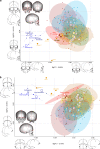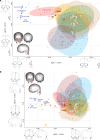Deciphering African late middle Pleistocene hominin diversity and the origin of our species
- PMID: 31506422
- PMCID: PMC6736881
- DOI: 10.1038/s41467-019-11213-w
Deciphering African late middle Pleistocene hominin diversity and the origin of our species
Abstract
The origin of Homo sapiens remains a matter of debate. The extent and geographic patterning of morphological diversity among Late Middle Pleistocene (LMP) African hominins is largely unknown, thus precluding the definition of boundaries of variability in early H. sapiens and the interpretation of individual fossils. Here we use a phylogenetic modelling method to predict possible morphologies of a last common ancestor of all modern humans, which we compare to LMP African fossils (KNM-ES 11693, Florisbad, Irhoud 1, Omo II, and LH18). Our results support a complex process for the evolution of H. sapiens, with the recognition of different, geographically localised, populations and lineages in Africa - not all of which contributed to our species' origin. Based on the available fossils, H. sapiens appears to have originated from the coalescence of South and, possibly, East-African source populations, while North-African fossils may represent a population which introgressed into Neandertals during the LMP.
Conflict of interest statement
The authors declare no competing interests.
Figures





References
-
- Bookstein, F. L. Morphometric Tools for Landmark Data: Geometry and Biology (Cambridge University Press, Cambridge, 1991).
Publication types
MeSH terms
LinkOut - more resources
Full Text Sources

